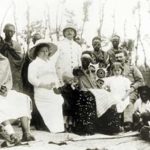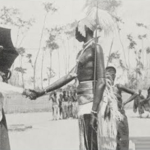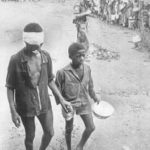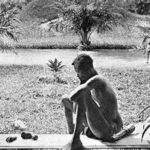Lineages And Ubuhake Clientship
We have seen that during Rwabugiri’s reign chiefs from central Rwanda introduced ubuhake clientship to Kinyaga. Unlike early
umuheto clientship, which usually involved the gift of a cow at regular intervals from a client lineage to its patron, ubuhake involved the transfer of one or several cows from patron to client. The client was entitled to usufruct (but not ownership) of the cow. Another important distinction lay in the different characteristics of clients in the two institutions: In umuheto the “client” was normally a kin group, and thus umuheto clientship could reinfoce small-scale horizontal ties; in ubuhake the client was usually an individual, so that where several members of a single lineage had different patrons this could weaken local solidarities.
But the differences were not always so greatbefore this century ubuhake clientship in Kinyaga resembled umuheto in important ways. At the time of Rwabugiri’s death in 1895, ubuhake was still rare in Kinyaga, and the full implications of individual clientship for corporate groups were not yet clear. Although lineage members who had ubuhake patrons were regarded as the individual client of their patron, the client ties could protect other members of the lineage as well. In the early years often only one or two members of a lineage became clients, and local corporate identity remained strong. Over time, however, ubuhake came to be preeminently an individual bond. Ubuhake ties reached farther down into the descent lines of single lineages, so that the sons of one man would often attach themselves to different patrons. To iffustrate this process, we will examine the client ties for several Kinyagan lineages, three from Impara, and three from Abiiru
The Abasigwa lineage at Gafuba first experienced ubuhake clientship at the end of the nineteenth century or early in the present century. Gasigwa, founder of the lineage, had no ubuhake ties, nor did his descendants in the next two generations. But this changed in the generation of Gasigwa’s great-grandsons. Among the eight sons of one grandson, five were ubuhake clients, with a total of four different patrons.
A similar pattern of gradual growthubuhake appears in client ties for the Abafanga lineage, also at Gafuba hill. Again, the earliest ubuhake clientship for the lineage occurred shortly before the death of Rwabugiri (1895) or not long afterward, when two of the three grandsons of Seegafanga, founder of the lineage, became ubuhake cattlee clients of Rwidegembya. Among the three sons of one of these clients, two were clients, each with a different patron. In the next generation, three of five sons were clients, again each to a different patron. In another branch of the lineage, all but one of the seven sons of the one son on whom data are available became ubuhake clients, with a total of five different patrons among them.The reasons why people sometimes abandoned clientship in the following generation.
The Abanyamagana lineage at Bunyangurube hill provides another example of how individual client ties reached into kin groups. For one of the branches descended from Nyamagana, founder of the lineage, only one of three gandsons sought ubuhake clientship. As in the case of the Abasigwa and Abafanga lineages, this initial ubuhake clientship occurred late in the reign of Rwabugiri, or a short time after his death. In the next generation, all six sons became ubuhake clients, to four different patrons.
Frequently, in cases where several members of a lineage were clients of different patrons, these patrons were themselves linked by kin ties. This was particularly noticeable during the early growth of ubuhake clientship, after the death of Rwabugiri in 1895.Itis illustrated clearly by the Abasigwa lineage, where eight patrons of lineage members were from the Abadegede lineage; only two patrons of the Abasigwa were from lineages other than the Abadegede. Therefore, although loyalties of the Abasigwa lineage members were cross-cut by individual ubuhake ties, control over the lineage from above was concentrated in a single local lineage.
We have seen in earlier chapters that the Abadegede were a Tuutsi lineage long established in Kinyaga and wealthy in cattle. Gafuba, like Shangi hill nearby, was a center of settlement for the Abadegede and several members of the lineage controlled pasturage near to where Abasigwa lineage members lived. Moreover, during the period 1900-1916 support for a leading member of the Abadegede from German authorities and from the central chief Rwidegembya had bolstered the power and prestige of this lineage. It was thus understandable that the Abasigwa cultivated a dense network of clientship ties to members of the Abadegede.
Ubuhake ties for the Abafanga lineage were more diverse than those of the Abasigwa. Among twelve patrons of Seekafanga’s descendants, four were Abadegede, two were Abakagara (Rwidegembya and his son, Rwagataraka both chiefs of Impala and hence “patrons” for several Abadegede), and two were members of another prominent lineage, the Abeerekande, linked to the Abadegede by marriage ties. The remaining four patrons each belonged to a different lineage. One of these, Seruvumba, was a half-brother of Rwagataraka through the maternal line and was therefore closely tied to the Abakagara lineage.
Patrons of the Abanyamagana lineage were also from a limited number of lineages. Two patrons of lineage members were Abadegede, while one was a member of the Abafata, a lineage closely related to the Abadegede. Three other patrons of lineage members came from two different lineages.
People in Abiiru region, like Impara experienced growth in ubuhake cattle clientship from the end of the nineteenth century.But in Abiiru fewer lineages became involved in this form of clientship and the number of patrons for members of one lineage was often quite small. For example, among the Abakaragata at Nyakarenzo the first ubuhake client ties appeared only during the early years of European rule; in the generation of Bukaragata’s great-grandsons, two of four brothers were clients.
Ubuhake ties were even more limited for the Abarari lineage at Rango and Murehe. For the generation of Murari’s great grand-sons in one branch of the lineage, only three of ten brothers had ubuhake patrons. One of these, was a client of Karara, son of Rwabugiri.
For this lineage, as for a number of other lineages in Abiiru region, umuheto ties remained strong through the early years of colonial rule and sometimes precluded the need for ubuhake patrons. Wealthy in cattle, the Abarari were considered to be of Tuutsi status. More important, the patrons of this lineage were influential in central politics. The Abarari had first been umuheto clients of Kanyonyomba (a delegate of Rwabugiri’s son Rutarindwa), but after the Rucunshu coup, they came under Kayondo (a member of the powerful Abakagara lineage which had masterminded the Rucunshu coup). One member of the Abarari lineage who was born before the Umuryamo cattle epidemic explained that as a youth he had paid court (guhakwa) at Kayondo’s residence in Nduga, thus fulfilling the obligations of the lineage toward its umuheto patron. But neither he nor his brothers were ubuhake clients—they received no cow from Kayondo.
The Abajyujyu lineage at Busekera and Ruhoko hills first acquired an ubuhake patron when Rwabugiri was living at his Ruganda residence near the Rusizi River. A grandson of the lineage founder cultivated ties to Rugereka, who was a powerfuI chief and close associate of the king. At the time, He possessed personally owned cattle, as well as an igikingi domain at Ruhoko. Oral histories of the lineage recount that he became Rugereka’s client because the chiefs of Rwabugiri were in the region seeking clients and he needed to protect his cows. In the next generation, among his six sons only one had an ubuhake patron.
Two conclusions emerge from these examples. First, in Abiiru as in Impara, ubuhake cattle clientship expanded during the last years of the nineteenth century and the first two decades of colonial rule, as individual lineages acquired multiple patrons. Second, an important result of this process was the erosion of lineage unity and a reduction in the autonomy of these groups. Ubuhake cattle clientship was less important as a means of dividing lineages in Abiiru than in Impara. However, the clientship involving transfer of a cow was not the only type of ubuhake tie. Another form of ubuhake found in both Impara and Abiiru (and perhaps more important in terms of numbers of people affected), was “clientship for land,” or as Kinyagans describe it, guhakirwa ubutaka. This involved performance of certain services for the local hill chief by the “client” but omitted the transfer of a cow. The services often duplicated those which in other contexts were reserved for clients who had received a cow: carrying the patron’s tobacco pouch and pipe, providing services to the patron’s household, accompanying the patron on voyages.
The significant aspect of ubuhake clientship, both for cattle and land, was its individual nature. If only very few members of a given lineage (or none) acquired patrons from whom they received a cow, several might become individual “land clients” of the local chief, particularly as hill chiefs became established and their powers augmented. For some lineages, land clientship served a function similar to that of cattle clientship by granting favored status in relation to the chief. Both types,land clientship and cattle clientship, served to reduce lineage’s autonomy.
https://uk.amateka.net/lineages-and-ubuhake-clientship/https://uk.amateka.net/wp-content/uploads/2019/11/ubuhake.jpghttps://uk.amateka.net/wp-content/uploads/2019/11/ubuhake-150x150.jpgChanges and ColonialismWe have seen that during Rwabugiri's reign chiefs from central Rwanda introduced ubuhake clientship to Kinyaga. Unlike early umuheto clientship, which usually involved the gift of a cow at regular intervals from a client lineage to its patron, ubuhake involved the transfer of one or several cows from patron to...BarataBarata rpierre@ikaze.netAdministratorAMATEKA | HISTORY OF RWANDA




